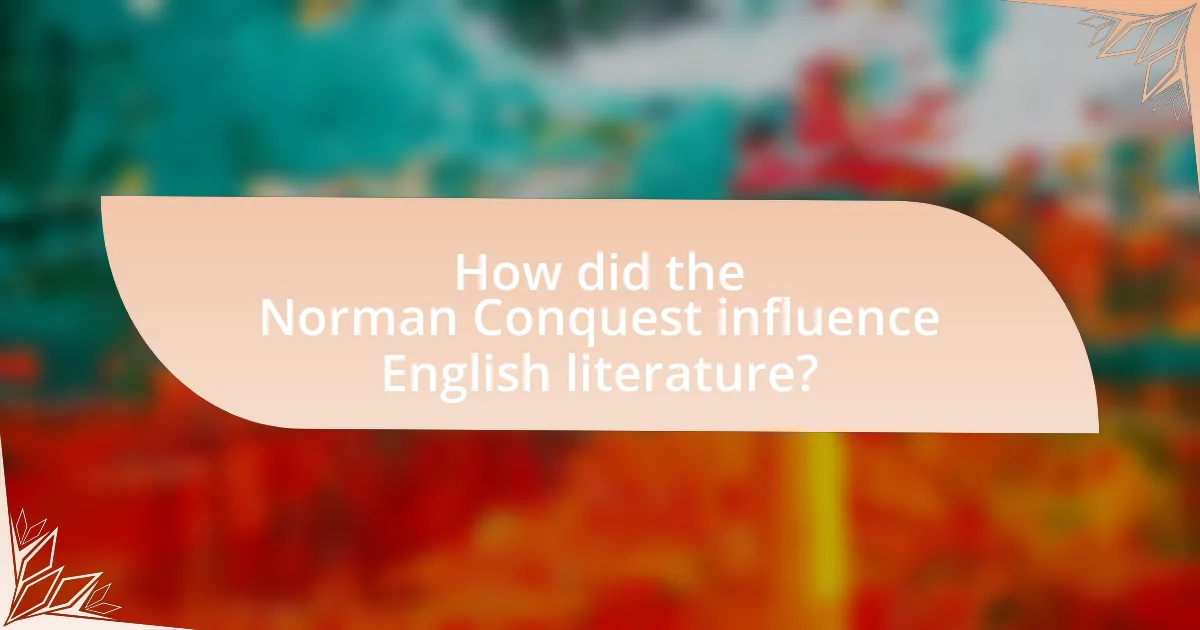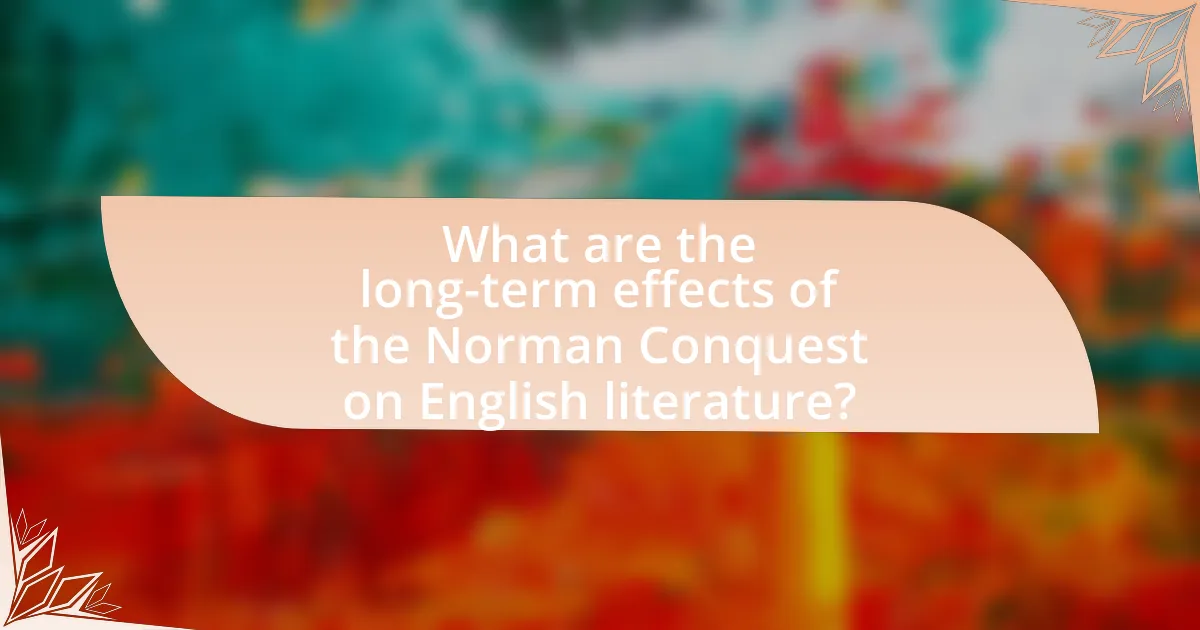The main entity of the article is the Norman Conquest and its profound impact on English literature. The article outlines how the 1066 invasion led by William the Conqueror transformed English society, governance, and culture, establishing Norman rule and introducing feudalism. It details the significant changes in land ownership, the integration of Norman French into the English language, and the emergence of a bilingual literary culture that enriched English vocabulary and themes. Key literary figures and works influenced by this cultural fusion are highlighted, along with the long-term effects on Middle English literature and the evolution of narrative forms, ultimately shaping the trajectory of English literary traditions.

What was the Norman Conquest and its significance?
The Norman Conquest was the invasion and occupation of England by the Normans in 1066, led by William the Conqueror following his victory at the Battle of Hastings. This event significantly transformed English society, governance, and culture, leading to the establishment of Norman rule and the introduction of feudalism. The Conquest also resulted in the integration of Norman French into the English language, which enriched English vocabulary and influenced literature, marking the beginning of a new literary era characterized by a blend of Anglo-Saxon and Norman traditions.
How did the Norman Conquest alter the social and political landscape of England?
The Norman Conquest significantly altered the social and political landscape of England by establishing Norman rule, which replaced the Anglo-Saxon elite with a new aristocracy loyal to William the Conqueror. This shift led to the redistribution of land, where approximately 60% of the land was granted to Norman nobles, fundamentally changing land ownership and governance structures. The introduction of the feudal system created a hierarchy that centralized power under the king, diminishing the influence of local Anglo-Saxon leaders. Additionally, the Conquest facilitated the integration of Norman culture and language, which influenced the development of English society and administration, as seen in the adoption of French as the language of the court and legal system. These changes laid the groundwork for the evolution of English identity and governance in the centuries that followed.
What were the immediate effects of the Norman Conquest on English society?
The immediate effects of the Norman Conquest on English society included significant changes in governance, land ownership, and social structure. Following the conquest in 1066, William the Conqueror redistributed land to his Norman followers, displacing many Anglo-Saxon nobles and establishing a feudal system. This shift resulted in the concentration of power among the Norman elite and the marginalization of the Anglo-Saxon population. Additionally, the introduction of the Norman language influenced the English language and culture, leading to a blend of Anglo-Saxon and Norman elements in society. Historical records, such as the Domesday Book, illustrate these changes by documenting land ownership and social hierarchy post-conquest.
How did the Norman Conquest influence the governance of England?
The Norman Conquest significantly transformed the governance of England by introducing a feudal system that centralized power under the monarchy. This shift allowed William the Conqueror to assert control over land and resources, redistributing them to his loyal nobles, which established a hierarchical structure of governance. The implementation of the Domesday Book in 1086 further exemplified this change, as it provided a comprehensive record of landholdings and resources, enabling more efficient tax collection and administration. This new governance model laid the foundation for the development of a more organized and bureaucratic state in England.
What were the cultural implications of the Norman Conquest?
The cultural implications of the Norman Conquest included the significant influence of Norman French on the English language and literature, leading to a bilingual society. Following the conquest in 1066, the ruling class spoke Norman French, while the majority of the population continued to speak Old English. This linguistic shift resulted in the incorporation of numerous French words into English, enriching its vocabulary and altering its structure. Additionally, the conquest facilitated the introduction of new literary forms and themes, as seen in works like “The Song of Roland” and the later development of Middle English literature, exemplified by Geoffrey Chaucer’s writings. The blending of Anglo-Saxon and Norman cultures fostered a unique literary tradition that reflected the complexities of identity and power in post-conquest England.
How did the Norman Conquest affect the English language?
The Norman Conquest significantly transformed the English language by introducing a substantial number of Norman French words and phrases into English vocabulary. This infusion occurred after the 1066 invasion, as the Normans became the ruling class in England, leading to the adoption of French as the language of the court, law, and administration. Consequently, many English words related to governance, art, literature, and cuisine were derived from French, enriching the English lexicon. For example, terms like “government,” “court,” “beauty,” and “beef” entered English during this period, illustrating the profound linguistic impact of the Norman Conquest.
What role did the Norman Conquest play in the fusion of cultures?
The Norman Conquest played a crucial role in the fusion of cultures by introducing Norman French language and customs to England, significantly influencing the English language and societal structures. Following the conquest in 1066, the Normans established themselves as the ruling class, which led to the integration of French vocabulary into English, particularly in law, art, and literature. This linguistic blend resulted in a richer, more diverse English language, as seen in the works of authors like Geoffrey Chaucer, who incorporated both Anglo-Saxon and Norman elements in his writings. The fusion of cultures also facilitated the exchange of ideas and artistic styles, contributing to the development of a distinct English identity that combined Anglo-Saxon traditions with Norman influences.

How did the Norman Conquest influence English literature?
The Norman Conquest significantly influenced English literature by introducing Norman French as a literary language alongside Old English. This bilingualism led to the incorporation of French vocabulary, themes, and styles into English literature, enriching its complexity and diversity. For instance, works like “Sir Gawain and the Green Knight” reflect this fusion, showcasing both Anglo-Saxon and Norman influences. Additionally, the establishment of the courtly love tradition and chivalric ideals in literature can be traced back to this period, as seen in the writings of poets such as Geoffrey Chaucer, who later integrated these elements into his works. The result was a transformation of English literature that laid the groundwork for the development of Middle English literature and the eventual emergence of the Renaissance literary tradition.
What literary changes occurred as a result of the Norman Conquest?
The Norman Conquest led to significant literary changes, primarily the introduction of Norman French as a literary language alongside Old English. This shift resulted in the emergence of a bilingual literary culture, where works began to be produced in both languages, influencing vocabulary, themes, and styles. The influence of French literature introduced new genres, such as romance and allegory, and contributed to the development of Middle English literature, exemplified by texts like “Sir Gawain and the Green Knight.” Additionally, the Conquest facilitated the incorporation of Latin and French literary traditions, enriching the narrative and poetic forms in English literature.
How did the introduction of Norman French impact English literary forms?
The introduction of Norman French significantly transformed English literary forms by enriching the vocabulary and introducing new genres. Following the Norman Conquest in 1066, the ruling class spoke Norman French, which led to a bilingual society where English absorbed a substantial number of French words, particularly in areas such as law, art, and literature. This linguistic infusion resulted in a more complex and nuanced English, allowing for greater expression in poetry and prose.
For instance, the works of Geoffrey Chaucer in the late 14th century exemplify this blend, as he incorporated both Anglo-Saxon and Norman French elements, creating a rich tapestry of language that appealed to a diverse audience. The shift also saw the emergence of new literary forms, such as the romance genre, which was heavily influenced by French literature. Thus, the impact of Norman French on English literary forms was profound, leading to a more sophisticated and varied literary tradition.
What new themes emerged in English literature post-Conquest?
Post-Conquest English literature saw the emergence of new themes such as feudalism, chivalry, and the interplay between the sacred and the secular. The introduction of the Norman ruling class brought a focus on the ideals of knighthood and courtly love, which were reflected in works like “Sir Gawain and the Green Knight.” Additionally, the blending of Anglo-Saxon and Norman French influences led to a richer exploration of identity and cultural conflict, as seen in texts like “The Canterbury Tales.” These themes were significant as they marked a shift from the primarily religious and heroic narratives of earlier literature to more complex social and personal themes.
Who were the key literary figures influenced by the Norman Conquest?
Key literary figures influenced by the Norman Conquest include Geoffrey of Monmouth, who wrote “Historia Regum Britanniae,” and Wace, known for his adaptation of the “Roman de Brut.” The Norman Conquest in 1066 led to significant changes in the English language and literature, as it introduced Norman French influences. Geoffrey of Monmouth’s work, written in Latin, incorporated these influences and contributed to the development of the Arthurian legend. Wace’s “Roman de Brut,” written in Old French, further exemplified the blending of cultures and languages that emerged post-conquest, showcasing the impact of Norman rule on English literary traditions.
What contributions did William of Poitiers make to English literature?
William of Poitiers significantly contributed to English literature through his historical writings, particularly “Gesta Guillelmi,” which chronicles the Norman Conquest of England. This work is notable for its detailed account of the events surrounding the conquest and provides insights into the political and social landscape of 11th-century England. The “Gesta Guillelmi” is one of the earliest examples of narrative history in English literature, blending historical fact with literary style, thereby influencing subsequent historical writing in England.
How did Geoffrey of Monmouth reflect the changes in literature after the Conquest?
Geoffrey of Monmouth reflected the changes in literature after the Conquest by introducing a blend of historical narrative and myth, which aligned with the emerging interest in national identity and the past. His work, particularly “Historia Regum Britanniae,” emphasized the importance of Arthurian legends and Welsh history, showcasing a shift from purely Latin scholarly texts to vernacular storytelling that appealed to a broader audience. This transition marked a significant departure from the Anglo-Saxon literary tradition, as Geoffrey’s incorporation of romance and legend into historical writing mirrored the cultural fusion resulting from the Norman influence, which sought to unify diverse narratives under a common national framework.

What are the long-term effects of the Norman Conquest on English literature?
The long-term effects of the Norman Conquest on English literature include the introduction of Norman French vocabulary and themes, which significantly enriched the English language and literary tradition. Following the Conquest in 1066, the ruling class spoke Norman French, leading to a bilingual society where English absorbed a vast number of French words, particularly in law, art, and literature. This linguistic blending is evident in works such as “Sir Gawain and the Green Knight” and the writings of Geoffrey Chaucer, who incorporated both Anglo-Saxon and Norman influences. Additionally, the Conquest shifted literary themes towards chivalry, courtly love, and the complexities of feudal society, which became prominent in medieval literature. The establishment of French as the language of the elite also led to a decline in the status of Old English literature until its revival in later centuries.
How did the Norman Conquest shape the development of Middle English literature?
The Norman Conquest significantly shaped the development of Middle English literature by introducing a wealth of French vocabulary and literary forms into the English language. Following the conquest in 1066, the ruling Norman elite spoke French, which led to the incorporation of French words and phrases into English, enriching its lexicon and enabling the emergence of a distinct Middle English dialect. This linguistic evolution is evident in works such as “Sir Gawain and the Green Knight” and “The Canterbury Tales,” which reflect a blend of Anglo-Saxon and Norman influences. Additionally, the conquest facilitated the rise of courtly literature and romance genres, as seen in the popularity of Arthurian legends, which were heavily influenced by French literature. The fusion of these cultural elements laid the groundwork for a more diverse and sophisticated literary tradition in England.
What are the defining characteristics of Middle English literature influenced by the Conquest?
Middle English literature influenced by the Conquest is characterized by the incorporation of French vocabulary, a shift in themes towards chivalry and courtly love, and the emergence of new literary forms such as the romance and the allegory. The Norman Conquest in 1066 led to the introduction of Norman French as the language of the ruling class, which significantly enriched the English lexicon. This linguistic influence is evident in works like “Sir Gawain and the Green Knight,” where the blend of Anglo-Saxon and Norman elements reflects the cultural fusion of the period. Additionally, the focus on chivalric ideals and courtly love in texts such as “The Canterbury Tales” illustrates the societal changes brought about by the Conquest, as literature began to mirror the values of the newly established Norman aristocracy.
How did the Norman Conquest pave the way for later literary movements?
The Norman Conquest significantly influenced later literary movements by introducing the French language and culture to England, which transformed English literature. This event in 1066 led to the establishment of Norman French as the language of the ruling class, resulting in a bilingual society where English and French coexisted. The infusion of French vocabulary and literary forms enriched the English language, paving the way for the development of Middle English literature. Notable works, such as Geoffrey Chaucer’s “The Canterbury Tales,” emerged from this linguistic evolution, showcasing a blend of Anglo-Saxon and Norman influences. The shift also encouraged the rise of courtly literature and romance genres, which became prominent in subsequent literary movements.
What lessons can be learned from the impact of the Norman Conquest on literature?
The impact of the Norman Conquest on literature teaches that cultural and linguistic shifts can significantly transform literary expression and themes. Following the Conquest in 1066, the introduction of Norman French influenced the English language, leading to a rich blending of Anglo-Saxon and Norman elements. This resulted in the emergence of Middle English literature, exemplified by works such as “Sir Gawain and the Green Knight” and the writings of Geoffrey Chaucer. The Conquest also highlighted the importance of social hierarchy and the feudal system in literature, as narratives began to reflect the complexities of class and power dynamics. Thus, the lessons learned emphasize the role of historical events in shaping literary forms and the evolution of language as a vehicle for cultural identity.
How can understanding this impact inform contemporary literary studies?
Understanding the impact of the Norman Conquest on English literature informs contemporary literary studies by highlighting the significant cultural and linguistic shifts that occurred in England during the 11th century. This historical event led to the introduction of Norman French as the language of the ruling class, which influenced the development of Middle English and the evolution of literary forms. For instance, the fusion of Anglo-Saxon and Norman French elements resulted in a richer vocabulary and new narrative techniques, as seen in works like “Sir Gawain and the Green Knight.” Analyzing these changes allows scholars to trace the lineage of English literature and understand how power dynamics and cultural exchanges shape literary expression.
What best practices can be derived from the evolution of literature post-Conquest?
Best practices derived from the evolution of literature post-Conquest include the integration of diverse linguistic influences, the blending of oral and written traditions, and the emphasis on narrative structure. The Norman Conquest in 1066 introduced Norman French into English literature, leading to a rich tapestry of vocabulary and stylistic elements that enhanced storytelling. This period saw the rise of works like “The Canterbury Tales,” which exemplified the fusion of different cultural narratives and the use of vernacular language, making literature more accessible to a broader audience. Additionally, the shift from purely oral traditions to written forms allowed for the preservation and dissemination of stories, ensuring their survival and evolution over time. These practices underscore the importance of cultural exchange and adaptability in literary development.